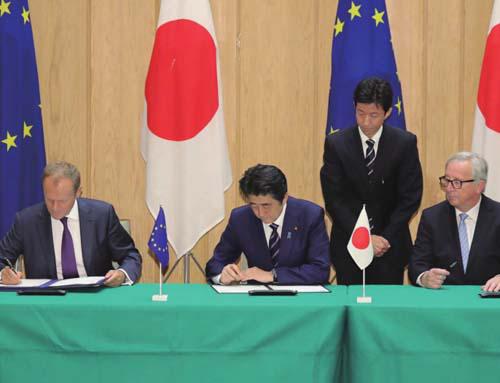Huddle Together
2018-08-24ByDongYifan
By Dong Yifan

The European Union (EU) and Japan signed the EU-Japan Economic Partnership Agreement (EPA) in Tokyo on July 17, marking the creation of one of the worlds largest free trade blocs covering 600 million people and constituting around 30 percent of the global GDP. Leaders from both sides have high expectations for the EPA. European Council President Donald Tusk described it as a “light in the darkness” for international trade while Japanese Prime Minister Shinzo Abe said that the EPA“shows the unwavering political resolve of Japan and the EU to lead the world as fl agbearers of free trade amid growing protectionism.”
The history of the EU-Japan EPA can be traced back to as early as May 2012 when Japan promised to reduce non-tariff barriers and gradually open its public procurement market, showing the EU its willingness to start negotiations on a free trade agreement (FTA). In July 2012, the European Commission asked EU member states for their approval to open negotiations for an FTA with Japan. The negotiations were then offi cially launched in March 2013.
Against the backdrop of the lingering European sovereign debt crisis and Japans“lost two decades,” the world economy faced the risk of falling into a double-dip recession while at the same time, emerging markets and developing economies enjoyed rapid growth. The EU and Japan started FTA negotiations with the aim of deepening cooperation and jointly exploring market potential and the power to shape rules amid fi nancial crises and global changes.
However, the EU and Japan have always been competitors in the global market, and they had differences in standards and regulations concerning products and services. Most importantly, as both sides prioritized the establishment of economic and trade relations with the United States, they focused mainly on FTA negotiations within the Trans-Pacific Partnership (TPP) and the Transatlantic Trade and Investment Partnership (TTIP), making the EU-Japan EPA process quite slow.
A joint response
The most important reason for the two sides fi nally accelerating their negotiations and signing the agreement was to cope with the “Trump shock.” Shortly after taking office, U.S. President Donald Trump, pursuing “America First” protectionist policies, regarded all countries that ran trade surpluses with the United States as “taking advantage,” and decided to withdraw from the TPP and freeze TTIP negotiations.
Japan and the EU faced unprecedented pressure from protectionism and the global trade patterns they had outlined were almost in vain. As the two largest developed economies after the United States, the EU and Japan began to probe into the role of the EPA in establishing free trade rules, consolidating existing global trade advantages and even seeking to fi ll the vacuum left by the United States.
On the eve of the 2017 Group of 20 Hamburg Summit, the EU and Japan reached a principled agreement on the EPA, which demonstrated their support for free and open trade and served as an important boost for subsequent negotiations. In December of that year, the two sides announced that negotiations on all issues were to be completed, except for the settlement of investment disputes, and they sped up the EPA process again.
This year, as the United States imposed specific tariffs on steel and aluminum and threatened to move on to automobiles, tensions rose. With the increasing protectionism, Japan and the EU strengthened their economic policy coordination and complained to the World Trade Organization(WTO) against U.S. steel and aluminum tariffs. Concurrently, their political will to reach the EPA was further enhanced, and in a culmination of all these factors, the EPA was signed.
The EU-Japan EPA is expected to boost the two export-oriented economies. It will not only gradually eliminate trade tariffs and non-tariff barriers between the two sides, the mutual openness in the areas of government procurement and trade in services will widen as well. Moreover, mutual recognition will be achieved on a geographical indication, data flow regulatory standards and other fields, which will greatly improve the convenience and openness of bilateral trade.
A report by the European Commission indicated that in 2017, the trade volume between the EU and Japan was $151.4 billion, accounting for 3.5 percent of the EUs foreign trade. Japan is the EUs sixth largest trading partner while the EU is Japans third largest trading partner. The EU expects that the full implementation of the EPA will contribute to a 0.14-percent increase in its GDP by 2035 and will increase exports to Japan by$15.2 billion.
Meanwhile, the Japanese Ministry of Foreign Affairs predicts that the EPA will help boost Japans GDP by nearly 1 percent and create 290,000 jobs. Japan will also portray the EPA as an important pillar of socalled Abenomics. Among the three arrows of Abes economic policies, the Japanese Government has relied more on proactive fi scal stimulus and a looser monetary policy from the Bank of Japan, but the structural reforms have been ineffective. Public opinion in Japan regards the EPA as an important achievement of structural reforms; thus it will help Abes administration achieve the goal of using external opportunities to promote domestic economic development.
New trade patterns
The EPA is of great significance in the reconstruction of global trade rules and patterns, with the two sides occupying 40 percent of the total global trade volume.The mutual recognition of rules and standards between the EU and Japan is not only a result of trade facilitation that will serve as a driving force for bilateral trade and investment, but also has implications for other countries.
The EU and Japan plan to shape and integrate rules on labor, environmental protection and product standards under the EPA, so that anyone who wants to compete for a share of the market will be required to follow these rules. Therefore, through this process, domestic companies from the EU and Japan will consolidate their existing competitiveness.
In its 2015 trade and investment strategy, the EU proposed FTAs as a tool to help expand EU values and standards. It also proposed the formation of a new global trade pattern with fewer tariffs and nontariff barriers, but with better rules and standards. At the same time, lack of progress in the WTO Doha Round negotiations and the development of free trade areas and regional cooperation mechanisms around the world represented the deconstruction of multilateral mechanisms. They also demonstrated the rearrangement and integration of systems among different economies, paving the way for a new system of global trade rules. The EU-Japan EPA is of vital importance in leading multilateral cooperation.
The EPA will exert its infl uence on trade liberalization in the Asia-Pacifi c region, the worlds most promising market. Major powers have increased their investment in this region in order to strengthen economic and trade ties with its countries. The region is the cornerstone of Japans economic and trade relations with the rest of the world, as evidenced by its continued efforts to maintain the TPP after the U.S. withdrawal, and finally pushing the remaining 11 countries to reach the Comprehensive and Progressive Agreement for Trans-Pacific Partnership (CPTPP).
With the signing of the EU-Japan EPA, Japan not only completed its basic free trade area layout, but it also maintained the overall framework of industrial rules set by developed countries. In addition, it left some room for the United States to return or for another layout guided by developed countries in the future.
The EU has continued to emphasize the importance of an FTA strategy in the Asia-Pacific region, signing an FTA with South Korea. FTA negotiations with Viet Nam and Singapore have been completed and negotiations with Australia and New Zealand have begun. The EU-Japan EPA gives the EU more confidence and power to shape rules in future FTA negotiations. At the same time, by adopting the rules set up by the EPA, the EU is also planning in advance for the return of the United States to global free trade.
On July 25, European Commission President Jean-Claude Juncker visited Trump and discussed economic and trade issues concerning the EU and the United States. In a joint communiqué, the two sides agreed to work together toward “zero tariffs, zero non-tariff barriers, and zero subsidies on non-auto industrial goods.”They discussed restarting TTIP negotiations, solving economic conflicts through bilateral negotiations and constructing a framework of transatlantic economic and trade rules.
In promoting the reform of the multilateral trade mechanism represented by the WTO, the EU and the United States have shown their willingness to strengthen communication and seek cooperation. The EPA, as a high-standard template of economic and trade rules, will play an important role in future bilateral negotiations between the EU and the United States, as well as between Japan and the United States. It may further help shape the CPTPP and even the WTO.
In their efforts to resist protectionism, the EU, Japan and other major economies in the world have launched a multi-pronged approach to safeguard their own interests. They have pursued bilateral and multilateral cooperation and at the same time maintained communication and coordination with the United States. These moves are intended to gain an advantage at a time when the global economic and trade patterns and rules will soon be changed.
China, as a main benefi ciary of multilateral trade rules, should carefully deal with the U.S.-initiated trade confrontation and strengthen its policy communication with other major trading partners. It also needs to uphold the legitimate interests of developing countries in the process of WTO reform and promote negotiations on the ChinaEU Bilateral Investment Treaty, the Regional Comprehensive Economic Partnership and other bilateral and multilateral trade and investment agreements.
